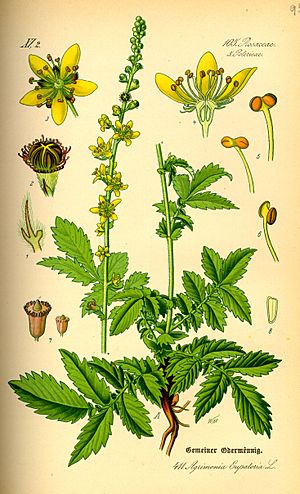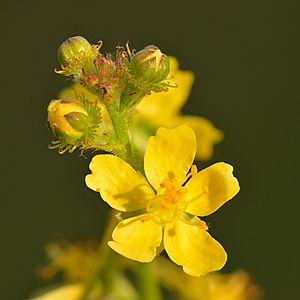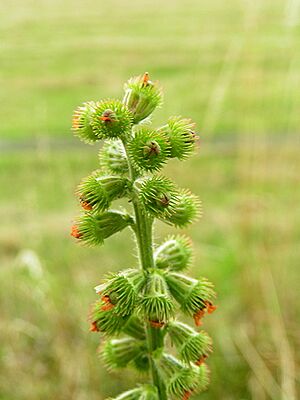Common agrimony facts for kids
Quick facts for kids Common agrimony |
|
|---|---|
 |
|
| Agrimonia eupatoria | |
| Scientific classification | |
| Genus: |
Agrimonia
|
| Species: |
eupatoria
|
Common agrimony is a wild plant also known as church steeples or sticklewort. It is a type of agrimony. This plant is dark green and covered in many soft hairs. These hairs help its seeds stick to animals or clothes, spreading them around. Its flowers have a nice, spicy smell, a bit like apricots. In the old "language of flowers," agrimony stands for thankfulness or gratitude.
The caterpillars of a moth called Endotricha flammealis like to eat this plant.
Contents
What Does Common Agrimony Look Like?
Plant Parts
Common agrimony is a plant that grows back every year. It can reach up to 100 centimeters (about 39 inches) tall. It has deep roots that spread underground, and new stems grow from these roots. Its leaves are easy to spot because they have jagged edges and are arranged like feathers.
Flowers and Seeds
The flowers of common agrimony bloom from June to September. They grow on tall, spike-like stems. Each flower is small and yellow, shaped like a tiny urn. The top edge of the flower has several rows of soft, hooked bristles. These bristles are about 1 to 4 millimeters long.
Each flower has five yellow petals and many stamens (the parts that make pollen). After the flowers are pollinated, they turn into small, burr-like fruits. These fruits are about 0.6 cm (0.2 inches) wide. They have hooks that help them stick to animal fur or clothing. Each fruit can hold one or two seeds.
Common agrimony grows naturally in Europe and Southwest Asia. You can find it in damp fields, along stream banks, and near bushes. People also grow it in other parts of the world, sometimes for its traditional uses.
Common Agrimony in Old Stories
People have believed in the special powers of agrimony for a very long time. Even ancient writers like Pliny the Elder mentioned it. Some old beliefs said it could help heal wounds.
An old British story says that if you put a sprig of agrimony under someone's head, they would sleep until you took it away!
How Agrimony Helps Nature
The bright yellow flowers of agrimony produce a lot of pollen. This pollen attracts many insects, like hoverflies, other flies, and honey bees. Butterflies, such as the grizzled skipper, also use agrimony as an important food source.
After the flowers are pollinated, they grow into fruits with burs. These burs easily attach to animals like cattle, sheep, and deer. This helps spread the seeds far and wide. Agrimony usually grows in younger grasslands, often less than 50 years old.
Images for kids
See also
 In Spanish: Agrimonia eupatoria para niños
In Spanish: Agrimonia eupatoria para niños




